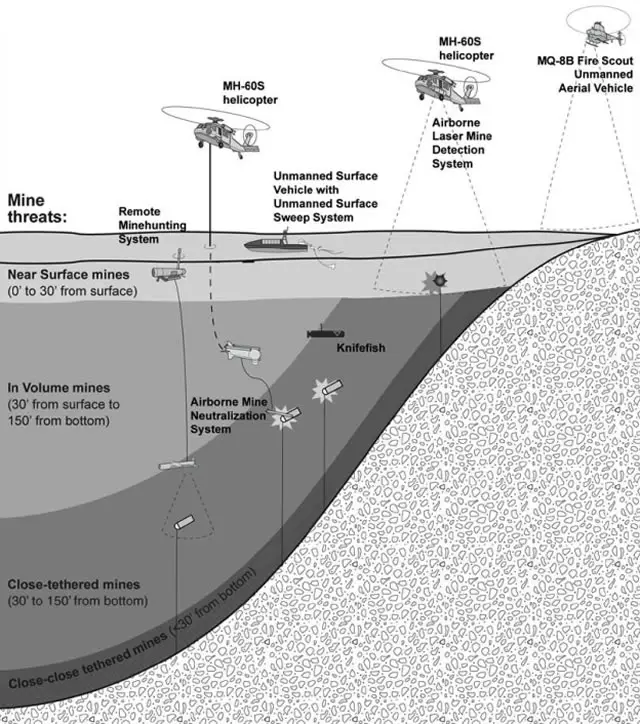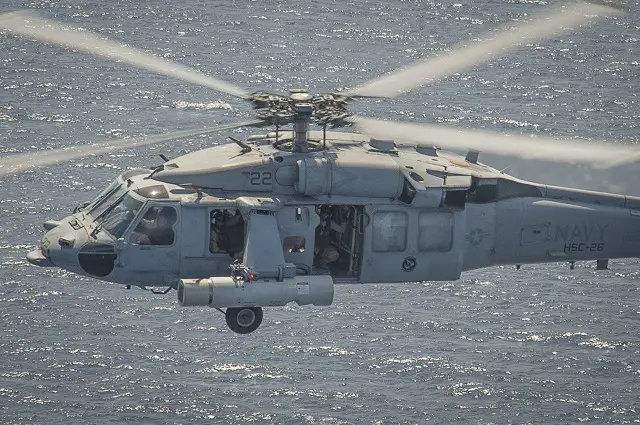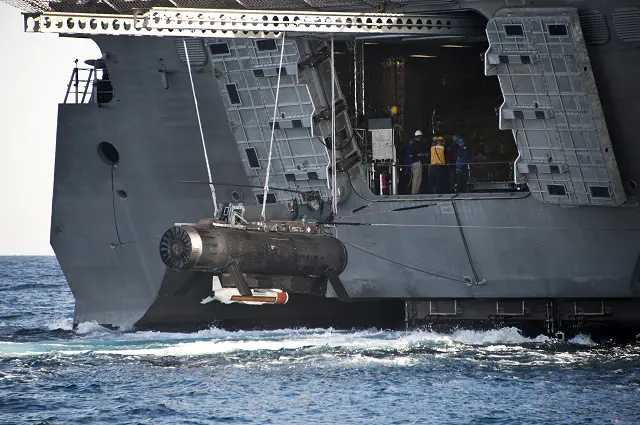|
|
| a |
Naval
Forces News - USA |
| |
|
| |
| |
U.S.
Navy's LCS MCM Mission Package Takes another Step Toward Fleet Implementation
|
| |
The U.S. Navy Naval Surface Warfare Center Panama City hosted a two-week
demonstration in July that verified Sailors' ability to conduct maintenance
on the Littoral Combat Ship's Mine Countermeasure Mission Package without
the assistance of civilian scientists or engineers.
The Littoral Combat Ship Mine Countermeasure Mission Package (LCS MCM
MP) Sustainment Demonstration (S-Demo) puts the Navy a step closer to
transitioning mine countermeasure mission modules to the fleet, offering
Joint Force Commanders mine detection and neutralization capability
that does not put ships at risk in minefields.
|
|
 Sketch explaining
the various components of the Littoral Combat Ship Mine Countermeasure
Mission Package (LCS MCM MP). Source: U.S. Government Accountability
Office
Sketch explaining
the various components of the Littoral Combat Ship Mine Countermeasure
Mission Package (LCS MCM MP). Source: U.S. Government Accountability
Office
|
|
The LCS MCM mission
package conducts its mine countermeasures operations through the employment
of aviation assets and unmanned surface, semi-submersible, and submersible
vehicles, equipped with an array of sensors and systems to detect,
localize, neutralize, and sweep mines. These systems are designed
to be employed while the LCS remains outside the mine threat area.
Future mission package increments add capability, including beach
zone mine detection, mine sweeping, near surface mine neutralization,
and buried and surf zone mine detection.
LCS MCM MP Features:
Remote Minehunting Module
» AN/WLD-1(V) Remote Multi-Mission Vehicle (RMMV) (2)
» AQS-20A
» Cradle Pallet Assembly
» Capture Spine
» Support Containers
Near Surface Detection Module
» MH-60S Helicopter
» AN/AES-1 Airborne Laser Mine Detection System (ALMDS)
» Support Containers
Airborne Mine Neutralization Module
» MH-60S Helicopter
» AN/ASQ-235 Airborne Mine Neutralization Systems (AMNS)
» EX 64 neutralizers
» Support Containers
Coastal Mine Reconnaissance Module
» AN/DVS-1 Coastal Battlefield Reconnaissance and Analysis (COBRA)
System
» MQ-8B Vertical Takeoff Unmanned Aerial Vehicle (VTUAV)
» Support Containers
Unmanned
Mine Sweeping Module
» Unmanned Surface Vehicle (USV)
» Unmanned Surface Sweep System (USSS)
» Support Containers
Buried Mine Hunting Module
» Surface Mine Countermeasure Unmanned Underwater Vehicle (SMCM
UUV) (Knifefish)
» Launch, handling and recovery equipment
» Support Containers
Mission Package Application Software (MPAS)
» Mission specific application software that support the MP
in planning and executing the MCM missions
» Mine Warfare and Environmental Decision Aids Library (MEDAL)
|
|
 NAVAL SUPPORT
ACTIVITY BAHRAIN (Aug. 4, 2014) An MH-60S Sea Hawk helicopter from the
Laser Hawks of Helicopter Sea Combat Squadron (HSC) 26, Detachment 2,
equipped with the Airborne Laser Mine Detection System (ALMDS) conducts
flight operations. Operated from the MH-60S helicopter, ALMDS provides
rapid wide-area reconnaissance and assessment of mine threats in littoral
zones, confined straits, and choke points. The Laser Hawks began the
operational testing and demonstration of ALMDS in the U.S. 5th Fleet
area of responsibility on the system's maiden deployment. (U.S. Navy
photo by Mass Communication Specialist 2nd Class Sean Furey/Released)
NAVAL SUPPORT
ACTIVITY BAHRAIN (Aug. 4, 2014) An MH-60S Sea Hawk helicopter from the
Laser Hawks of Helicopter Sea Combat Squadron (HSC) 26, Detachment 2,
equipped with the Airborne Laser Mine Detection System (ALMDS) conducts
flight operations. Operated from the MH-60S helicopter, ALMDS provides
rapid wide-area reconnaissance and assessment of mine threats in littoral
zones, confined straits, and choke points. The Laser Hawks began the
operational testing and demonstration of ALMDS in the U.S. 5th Fleet
area of responsibility on the system's maiden deployment. (U.S. Navy
photo by Mass Communication Specialist 2nd Class Sean Furey/Released)
|
|
"The
purpose of the S-Demo is to identify gaps in training, processes, and
procedures to make sure gaps are minimized for future operations and
support," said Michelle Parker, NSWC PCD S-Demonstration Test Team.
During the demonstration, Sailors assigned to operate and maintain the
MCM package, the Littoral Combat Ship Squadron (LCSRON) Mission Package
detachment, followed systems and processes in place to perform maintenance
tasks on the deployable LCS mine countermeasures equipment, while civilian
scientists and engineers collected data. The data gathered will help
to improve maintenance processes Sailors will use while on deployment. |
|
 GULF OF MEXICO
(Jan. 7, 2012) The Remote Minehunting System (RMS) and an AN/AQS-20
mine hunting sonar are brought aboard the littoral combat ship USS Independence
(LCS 2) during developmental testing of the mine warfare mission module
package.
GULF OF MEXICO
(Jan. 7, 2012) The Remote Minehunting System (RMS) and an AN/AQS-20
mine hunting sonar are brought aboard the littoral combat ship USS Independence
(LCS 2) during developmental testing of the mine warfare mission module
package.
(U.S. Navy photo by Ron Newsome/Released)
|
|
"It's
our way of ensuring the requisite amount of technical rigor is in place
to ensure program success, because at the end of the day we must provide
a safe and effective solution to the Fleet," said Ed Stewart, NSWC
Panama City Technical Director.
By better estimating the actual time required to perform corrective
and preventative maintenance, the sailors have more accurate data when
calculating the time necessary to clear a minefield or complete a specific
tactic at sea. |







